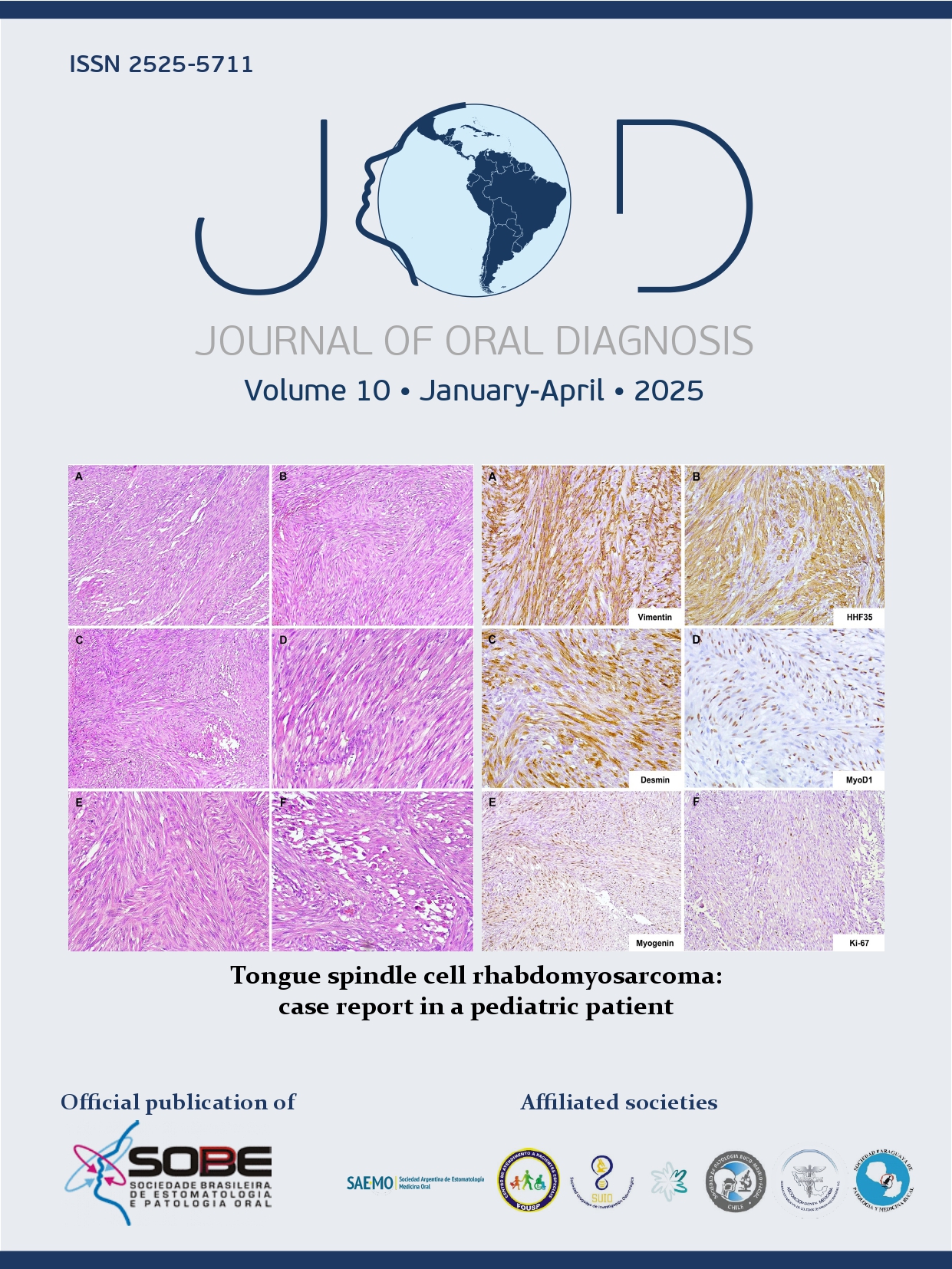Oral leukoplakia evaluation through clinical photography: classification, interactive segmentation, and automated binarization before going on Artificial Intelligence algorithms
DOI:
https://doi.org/10.5935/2525-5711.20230224Keywords:
Artificial Intelligence, Photography, Leukoplakia, OralAbstract
Oral leukoplakia (OL) evaluation through photographs can be performed with the aid of Artificial Intelligence (AI). Supervised Machine Learning (SML) processes, which are based on labeling, are indicated to ensure a reliable computational mechanism of lesion identification. Thus, OL classification and demarcation within a photograph are crucial for SML. Objective: To label OL lesions in homogeneous and non-homogeneous using photographs, and to test a segmentation procedure, aiming for its use in a trustworthy dataset. Methods: Fifty-five OL photographs were inserted into Fiji/ImageJ, and a region of interest (ROI) was defined to obtain a three-dimensional plot of pixel color clustering. Then, the photography and the plot were used for OL classification by a panel of 5 experts in Oral Medicine. The segmentation process was performed by two operators which created a second ROI for evaluation of the lesion by area, perimeter, centroid, and circularity. The intraclass correlation coefficient was calculated and a comparative analysis was performed (Mann Whitney and Unpaired t-test). Then, segmentation was accomplished by creating a computer code including the precise information of the lesional site, in an automated binarization fashion. Results: The experts agreed in 53% of the cases regarding OL classification. An excellent level of operator agreement related to the size and site of the lesion was found. Although, differences were found comparing the lesion's area, perimeter, and centroid (p<0.05). The code was effective for the segmentation separating the lesion from the background. Conclusion: The agreement on OL classification among experts accounted for half of the cases. The lesion segmentation was possible using a computer code based on interactive drawing. With an excellent agreement between operators, the manual delimitation of lesional sites can be used for SML, but the differences regarding lesional perimeter and its classification should be considered before labeling and creating a good dataset.
References
Warnakulasuriya S, Johnson NW, Van Der Waal I. Nomenclature and classification of potentially malignant disorders of the oral mucosa. J Oral Pathol Med. 2007 Jul;36(10):575-80. DOI: https://doi.org/10.1111/j.1600-0714.2007.00582.x
Mello FW, Miguel AFP, Dutra KL, Poporatti AL, Warnakulasuriya S, Guerra ENS, et al. Prevalence of oral potentially malignant disorders: A systematic review and meta-analysis. J Oral Pathol Med. 2018 May;47(7):633-40. DOI: https://doi.org/10.1111/jop.12726
McCullough MJ, Prasad G, Farah CS. Oral mucosal malignancy and potentially malignant lesions: an update on the epidemiology, risk factors, diagnosis and management. Aust Dent J. 2010;55(Suppl 1):S61-S5. DOI: https://doi.org/10.1111/j.1834-7819.2010.01200.x
Axéll T, Pindborg JJ, Smith CJ, Van Der Waal I. Oral white lesions with special reference to precancerous and tobacco-related lesions: conclusions of an international symposium held in Uppsala, Sweden, May 18-21 1994. J Oral Pathol Med. 1996 Feb;25(2):49-54. DOI: https://doi.org/10.1111/j.1600-0714.1996.tb00191.x
Paglioni MP, Khurram SA, Ruiz BII, Lauby-Secretan B, Normando AG, Ribeiro ACP, et al. Clinical predictors of malignant transformation and recurrence in oral potentially malignant disorders: a systematic review and meta-analysis. Oral Surg Oral Med Oral Pathol Oral Radiol. 2022 Nov;134(5):573-87. DOI: https://doi.org/10.1016/j.oooo.2022.07.006
Ahn C, Salcido RS. Advances in wound photography and assessment methods. Adv Skin Wound Care. 2008;21(2):85-93. DOI: https://doi.org/10.1097/01.ASW.0000305411.58350.7d
Lin I, Datta M, Laronde DM, Rosin MP, Chan B. Intraoral photography recommendations for remote risk assessment and monitoring of oral mucosal lesions. Int Dent J. 2021 Oct;71(5):384-9. DOI: https://doi.org/10.1016/j.identj.2020.12.020
Alabi RO, Elmusrati M, Sawazaki-Calone I, Kowalski LP, Haglund C, Coletta RD, et al. Machine learning application for prediction of locoregional recurrences in early oral tongue cancer: a Web-based prognostic tool. Virchows Arch. 2019 Aug;475(4):489-97. DOI: https://doi.org/10.1007/s00428-019-02642-5
Araújo ALD, Souza ESC, Faustino ISP, Salvidia-Siracusa C, Brito-Sarracino T, Lopes MA, et al. Clinicians' perceptions of oral leukoplakia: a pitfall for image annotation in Supervised Learning. Oral Surg Oral Med Oral Pathol Oral Radiol. 2023 Mar 06; [Epub ahead of print]. DOI: https://doi.org/10.1016/j.oooo.2023.02.018
Mahmood H, Shaban M, Indave BI, Santos-Silva AR, Rajpoot N, Khurram SA. Use of artificial intelligence in diagnosis of head and neck precancerous and cancerous lesions: a systematic review. Oral Oncol. 2020;110:104885. DOI: https://doi.org/10.1016/j.oraloncology.2020.104885
Czerninski R, Mordekovich N, Basile J. Factors important in the correct evaluation of oral high-risk lesions during the telehealth era. J Oral Pathol Med. 2022 Aug;51(8):747-54. DOI: https://doi.org/10.1111/jop.13343
Ilhan B, Guneri P, Wilder-Smith P. The contribution of artificial intelligence to reducing the diagnostic delay in oral cancer. Oral Oncol. 2021 Dec;116:105254. DOI: https://doi.org/10.1016/j.oraloncology.2021.105254
Dastjerdi HM, Töpfer D, Rupitsch SJ, Maier A. Measuring surface area of skin lesions with 2D and 3D algorithms. Int J Biomed Imaging. 2019;2019:4035148. DOI: https://doi.org/10.1155/2019/4035148
Gomes RFT, Schmith J, Figueiredo RM, Freitas AS, Machado GN, Romaninin J, et al. Use of artificial intelligence in the classification of elementary oral lesions from clinical images. Int J Environ Res Public Health. 2023 Feb;20(5):3894. DOI: https://doi.org/10.3390/ijerph20053894
Welikala RA, Remagnino P, Lim JH, Chan CS, Rajedran S, Kallarakkal TG, et al. Automated detection and classification of oral lesions using deep learning for early detection of oral cancer. IEEE Access. 2020 Jul;8:132677-93. DOI: https://doi.org/10.1109/ACCESS.2020.3010180
Souza LL, Fonseca FP, Araújo ALD, Lopes MA, Vargas PA, Khurram SA, et al. Machine learning for detection and classification of oral potentially malignant disorders: a conceptual review. J Oral Pathol Med. 2023 Mar;52(3):197-205. DOI: https://doi.org/10.1111/jop.13414
Published
How to Cite
Issue
Section
License
Copyright (c) 2023 Matheus de-Abreu, Thais dos-Reis, Camila de Barros Gallo, Alessandra Rodrigues de-Camargo, Liliane Janete Grando, Ricardo Armini Caldas, Gustavo Davi Rabelo

This work is licensed under a Creative Commons Attribution 4.0 International License.










